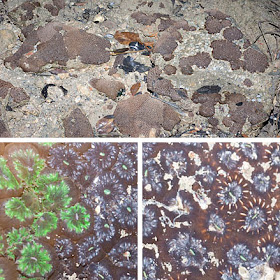There are lots of nudibranchs even on Changi! Today, I came across a whole bunch of them, crammed together busy laying egg ribbons.
Together, the team covered a whole stretch of Changi as we spread out over this low spring tide. Lots of amazing sightings!
I started the trip at a stretch of rocky shore that I last visited in Aug 2011. There were lots of these colourful spotty nudibranchs everywhere. They are a yet to be identified Hypselodoris that we often see on our Northern shores.
This Orange sea cucumber has a coil of what seems to be a nudibranch egg ribbon laid on it. Nudis usually lay their eggs on or near their food source. Oh dear, I don't think nudis eat sea cucumbers. But who knows!
Today, the tide is very very low. So I could get a better glimpse of the amazing marine life found in the murky water here. The water is still murky, but at least it's lower. There are lots of sea fans here, as well as sponges and soft corals and hydroids. Squid egg capsules have been laid on one hydroid, synaptid sea cucumbers curl around sponges, feather stars festoon the shores and cerianthids 'bloom' everywhere.
Colourful sponges grow on all hard surfaces here including artificial structures. Today I saw lots of little Blue spotted flatworm (cf Pseudoceros indicus) everywhere.
In places which are not heavily impacted by fishing, clusters of large sea fans (Order Gorgonacea) have settled on the rocks. Elsewhere, I see fishing line entangled in dead or dying sea fans, or simply no sea fans at all.
Among the abundant sea fans on the shore were Gnarled sea fans, and Candelabra sea fans. Each is a colony of tiny polyps emerging from a central 'branch'.
Also common were Skinny sea fans, which can grow very large on this shore.
Sea fans are a great home for all kinds of tiny animals. Such as Ovulid snails and tiny brittle stars.
Here's a closer look at the little Red ovulid snails. The snail covers its shell with its body mantle which has bumps that resemble the while polyps of the sea fan! These snails may eat the sea fan.
A closer look at the beautiful Colourful tiny brittle stars (Ophiothela danae) that wrap themselves around sea fans.
I only saw one colony of Pink flowery soft coral and one tiny Ball flowery soft coral. I couldn't find any animals living in them.
There were also large 'bushes' of these nasty Stinging hydroids. They pack a powerful sting that can 'burn' skin and take a long time to heal.
Some parts of the rocky shore were covered with lots and lots of Zebra corals (Oulastrea crispata). Finally, I managed to get a photo of the coral polyps that are green and bluish. I often wondered if the green and blue ones were the same. It seems the polyp has a green central disk?
I saw several feather stars (Order Crinodea), here's one nicely relaxing in a pool of water.
Wow, a Baler snail (Melo melo)! My first encounter on this shore. It wasn't very large, I hope it grow up safely as these snails tend to be collected, apparently to be eaten.
I had a closer look at the rocks and saw this mama Ovum cowerie (Cypraea ovum) protecting her egg mass with her large foot. There were lots of other creatures under the stones and rocks too. I also saw many Crown sea stars (Asterina coronata) here.
I saw plenty of these blue-legged Striped hermit crabs (Clibanarius infraspinatus) today. Not sure why.
As at Punggol yesterday, large areas of the rocks and the shore was covered in a soft layer of nest mussels (Musculista senhousia) that create a carpet of tangled byssus threads to live in. Today I saw few zoanthids (Order Zoanthidea), probably they were smothered by the nest mussels. I was very surprised to see seagrasses growing on this carpet. The seagrasses were well rooted into the felt-like layer of 'nesting material' created by the mussels.
The seagrasses have narrow blades and had suspicious speckles on them. Are they the Hairy spoon seagrass (Halophila decipiens)? Mei Lin also spotted similar looking seagrasses yesterday at Punggol.
I took a closer look at the seagrasses, and they don't seem to have hairs on the leaf blades. So once again, probably not Halophila decipiens? We will have to ask Siti.
Alas, I also came across several fish traps, most seem abandoned, as well as some large debris. Marine life have started growing on some of them.
After the rocky shore, I did a short stretch of a sandy shore on Changi that I seldom visit. My last trip here was in Nov 2011. This shore had some Cake sand dollars (Arachnoides placenta), lots of sea pencils, and I spotted one Peachia anemone (Peachia sp.).
I also saw this large sea anemone which I think is the Very long sea anemone! My first sighting of it in the North!
There were lots and lots of tiny hermit crabs huddled on the sand bar. I find such gatherings an easy and quick way to find out what snails are common in the area!
I was surprised to see some seagrasses growing on the very low water line which was exposed on this super low spring tide today. There were small clumps of Spoon seagrass (Halophila ovalis) with large leaf blades and Fern seagrass (Halophila spinulosa).
The rest of the team had lots of wonderful sightings at another stretch of Changi: electric ray, rare snails and more! For more, see the posts by Mei Lin, Pei Yan and Marcus.
But the most amazing find to me was this weird creature that I've never seen before.
Tomorrow, another adventure on another super low spring tide. Alas, also well before dawn.


























